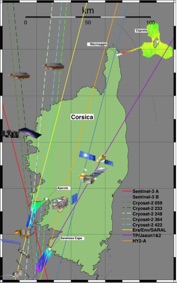Abstract's details
Corsica: a multi-mission absolute calibration site
Event: 2016 Ocean Surface Topography Science Team Meeting
Session: Regional and Global CAL/VAL for Assembling a Climate Data Record
Presentation type: Oral
In collaboration with the CNES and NASA oceanographic projects (T/P and Jason), the OCA developed a verification site in Corsica since 1996. CALibration/VALidation embraces a wide variety of activities, ranging from the interpretation of information from internal-calibration modes of the sensors to validation of the fully corrected estimates of Sea Surface Heights using in situ data. Now, Corsica is, like the Harvest platform (NASA side), an operating calibration site able to support a continuous monitoring with a high level of accuracy: a ’point calibration’ which yields instantaneous bias estimates with a 10-day repeatability of around 30 mm (standard deviation) and mean errors of 3-4 mm (standard error). For a 35-day repeatability (ERS, EnviSat, SARAL/AltiKa), due to a smaller time series, the standard error is about the double (~7 mm).
In-situ calibration of altimetric height (SSH for ocean surfaces) is usually done at the vertical of a dedicated CAL/VAL site, by direct comparison of the altimetric data with in-situ data. Adding the GPS-based sea level measurements to the “traditional” tide gauges ones, it offers the great opportunity to perform a cross control that is of importance to insure the required accuracy and stability. This configuration leads to handle the differences compare to the altimetric measurement system at the global scale: the Geographically Correlated Errors at regional (orbit, sea state bias, atmospheric corrections...) and local scales (geodetic systematic errors, land contamination for the instruments, e.g. the radiometer).
Our CAL/VAL activities are thus focused not only on the very important continuity between past, present and future missions but also on the reliability between offshore and coastal altimetric measurement. With the extension of the Corsica site (Capraia in 2004 and Ajaccio in 2005), we are now able to perform absolute altimeter calibration for ERS -2, EnviSat, HY-2A, CryoSat-2 and SARAL/AltiKa with the same standards and precision than for T/P and Jason missions. The Sentinel-3 mission is also naturally included in our CAL/VAL activities. This will permit to improve the essential link between all these long time series of sea level observation.
The presented results will include the full set of TOPEX/Poseidon, Jason-1 and Jason-2 GDR products. Updated values of the SSH bias for Jason-1 based on GDR-E will be also presented. However, this presentation will be focused on Jason-3 data and the comparison with Jason-2 over the Formation Flight Period. Early results for Jason-3 (cycle 1-4) showed an absolute SSH bias of -38 mm.

In-situ calibration of altimetric height (SSH for ocean surfaces) is usually done at the vertical of a dedicated CAL/VAL site, by direct comparison of the altimetric data with in-situ data. Adding the GPS-based sea level measurements to the “traditional” tide gauges ones, it offers the great opportunity to perform a cross control that is of importance to insure the required accuracy and stability. This configuration leads to handle the differences compare to the altimetric measurement system at the global scale: the Geographically Correlated Errors at regional (orbit, sea state bias, atmospheric corrections...) and local scales (geodetic systematic errors, land contamination for the instruments, e.g. the radiometer).
Our CAL/VAL activities are thus focused not only on the very important continuity between past, present and future missions but also on the reliability between offshore and coastal altimetric measurement. With the extension of the Corsica site (Capraia in 2004 and Ajaccio in 2005), we are now able to perform absolute altimeter calibration for ERS -2, EnviSat, HY-2A, CryoSat-2 and SARAL/AltiKa with the same standards and precision than for T/P and Jason missions. The Sentinel-3 mission is also naturally included in our CAL/VAL activities. This will permit to improve the essential link between all these long time series of sea level observation.
The presented results will include the full set of TOPEX/Poseidon, Jason-1 and Jason-2 GDR products. Updated values of the SSH bias for Jason-1 based on GDR-E will be also presented. However, this presentation will be focused on Jason-3 data and the comparison with Jason-2 over the Formation Flight Period. Early results for Jason-3 (cycle 1-4) showed an absolute SSH bias of -38 mm.
Contribution: CVL_04_CALVAL-Bonnefond_et_al-OSTST-2016_14h45.pdf (pdf, 2131 ko)
Back to the list of abstract